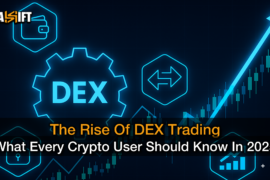2025 Crypto Market Guide | Welcome to the 2025 Crypto Market Guide: Best Practices and Learning Opportunities! This is one of the fastest-evolving areas, so one must keep oneself informed and adaptable. The year 2025 is a critical juncture for the complete overhaul of this industry with new regulatory mechanisms, blockchain improvements, and fresh market dynamics. Whether you are an ambitious investor, curious newbie, or excited blockchain user, this text will help you understand the complexities and opportunities of 2025’s crypto market.
This comprehensive guide looks at strategies to minimize risk, how to leverage emerging technologies in your favor, and the learning opportunities available to build your crypto expertise. Master these best practices, and set yourself up for success in this ever-changing world of digital assets. Let’s do this together and unlock the full potential of the 2025 crypto market!
To exchange cryptocurrency at the best rate, visit the Flashift website, create a registration-free transaction, and take advantage of a secure and speedy experience.
Introduction to the 2025 Cryptocurrency Landscape
By the year 2025, the state of the cryptocurrency market will reach that coveted juncture of innovation and maturity. Wide acceptance of blockchain technology, greater clarity on regulations in several markets, and an ever-improving ecosystem of use cases have turned the crypto space into a cornerstone of the modern global financial system. In this section, the Crypto Market Guide 2025 covers the general overview of the current market and sheds light on the trend, which is expected to shape the future.

Current State of the Crypto Market
Cryptocurrencies have journeyed from niche investments to mainstream financial instruments in recent years. Major corporations, hedge funds, and even central banks have increased institutional adoption by integrating digital currencies into their operations. Decentralized finance protocols have evolved to the point where several sophisticated financial products, yield farming, insurance, etc., are available today. In the process, tokenization opens new avenues in real estate, gaming, and art.
Though quite volatile, this was accompanied by continuous growth in the total market capitalization of cryptocurrencies. Further, stablecoins became a bridge between traditional finance and crypto, while Layer 2 scaling solutions answered many questions on transaction speed and costs.
Projected Trends for 2025
- Regulatory Advancements:
Governments worldwide are establishing more lucid frameworks to regulate cryptocurrencies, thus making them safer for investors while being innovative. The introduction of CBDCs has raised discussions on coexistence with decentralized cryptocurrencies.
- Institutional Expansion:
Institutional inroads are expected to get deeper. Traditional banks and investment houses offer crypto-related services such as custodial solutions and blockchain-based settlements.
- Increased Utility:
Beyond investment, cryptocurrencies increasingly find their place in day-to-day transactions, cross-border payments, and supply chain solutions. Integrating blockchain with Web3 and the metaverse is also bound to extend use cases.
- AI and Blockchain Convergence:
Another emerging trend in 2025 is the integration of Artificial Intelligence (AI) with blockchain technology. AI-driven smart contracts, predictive trading algorithms, and decentralized autonomous organizations (DAOs) are gaining traction, promising increased efficiency and automation in the crypto industry. This fusion is particularly relevant in DeFi (Decentralized Finance), where AI can optimize lending rates, automate compliance checks, and detect fraudulent activities in real time. As this trend grows, it could redefine how businesses and individuals interact with digital assets.
- Sustainability Efforts:
Projects focusing on energy-efficient consensus mechanisms, such as proof-of-stake and next-generation solutions, will dominate with the rise in environmental concerns.
This dynamic landscape brings opportunities and challenges, making 2025 a critical year for established and new cryptocurrency participants. As you read further into this guide, you will understand what it takes to navigate and prosper in this ever-changing crypto market.
For exchanging Tether (USDTERC20) to Bitcoin (BTC) in one second, Flashift is the easiest way.
Essential Best Practices for Crypto Investors in 2025
The cryptocurrency market 2025 offers excellent opportunities, yet it must be approached cautiously. As the markets become more complex and technologies change, investors need to develop informed strategies. This 2025 Crypto Market Guide section presents some key best practices for efficient investment and risk management, helping you stay ahead in this dynamic landscape.
-
Diversify Your Portfolio
Variegation is one of the safest ways to decrease risk. A well-balanced cryptocurrency portfolio may look something like this:
- Blue-Chip Cryptocurrencies: Relatively established coins like Bitcoin and Ethereum that still serve as market anchors.
- Emerging Altcoins: This class includes newer promising projects serving real-world utilities, DeFi gaming, and sustainability projects.
- Stablecoin: This is used to preserve value and ensure liquidity, especially during volatile market trends.
The 2025 Crypto Market Guide emphasizes that spreading investments across different sectors and blockchain ecosystems reduces exposure to market downturns in specific areas.
2. Stay Informed About Regulations
Regulatory landscapes are changing very fast. Understand the regulations and laws in your country regarding taxation, reporting, and compliance requirements for crypto investments. Adherence to these regulatory frameworks will save you from legal hassles and align with broader market developments. Updates on the U.S., EU, and Asia are best according to the 2025 Crypto Market Guide.
-
Leverage Risk Management Tools
Managing volatility is essential in crypto. Strategies include:
- Set Stop-Loss Orders: Protect your portfolio from huge losses by automatically exiting when the prices fall below a pre-defined level.
- Position Sizing: One should not over-invest in a single asset. Allocate only a small percentage of one’s portfolio to high-risk investments.
- Hedging Strategy: Reduce your exposure using some derivative instrument, such as futures or options, during uncertain market conditions.
-
Research Before Investment
Please do your diligence on any project before investing. Key areas to focus on will include:
- Team and Vision: The project should have a credible team and a well-defined purpose.
- Tokenomics: Token supply, distribution model, and utility within the ecosystem.
- Community and Adoption: The community’s engagement and the project’s real-world use cases.
Following these principles from the 2025 Crypto Market Guide allows you to make quality investments without being caught in a scam or unsustainable project.
-
Prioritize Security
In 2025, the crypto market will be much safer, yet it is still a risky venture. The minimum security habits you should acquire include the following:
- Hardware wallets for secure asset storage.
- MFA on exchanges.
- Avoid phishing and protection of private keys.
-
Focus on Long-Term Growth
While crypto markets are known for their short-term volatility, long-term trends often provide stability and growth. Invest in projects with sustainable value propositions and give your assets time to mature. Avoid chasing quick gains or “FOMO” (fear of missing out).
By following these best practices, you can face the crypto market confidently. The 2025 Crypto Market Guide reiterates that success in the emerging crypto landscape demands discipline, adaptability, and informed decision-making.
Top Learning Resources for Cryptocurrency Enthusiasts
Success in fast-moving cryptocurrency requires constant learning and information. The Crypto Market Guide for 2025 highlights the best courses, books, and platforms to help enthusiasts of all skill levels explore blockchain technology, crypto investing, and DeFi more deeply.

Recommended Online Courses
- Blockchain Fundamentals (University of California, Berkeley—edX): This course is meant for beginners and provides an understanding of the core concepts of blockchain technology, its history, functionality, and use cases.
- DeFi and the Future of Finance (Coursera, University of Nicosia): This advanced course covers decentralized finance, smart contracts, and emerging financial models. It is intended for intermediate learners.
- Certified Cryptocurrency Trader (Blockchain Council): This certification course is especially for aspiring traders. It encompasses technical analysis, market trends, and trading strategies tailored to cryptocurrencies.
- Crypto Taxation and Compliance Masterclass: With regulatory pressures increasing, this master class prepares learners to deal with taxation, legal compliance, and reporting in crypto 2025.
Essential Books for Crypto Enthusiasts
- “The Bitcoin Standard” by Saifedean Ammous
A timeless classic explaining the economic principles behind Bitcoin and its potential to revolutionize global finance. - “Mastering Ethereum” by Andreas M. Antonopoulos and Gavin Wood
A deep dive into Ethereum’s architecture, smart contracts, and decentralized applications, suitable for developers and enthusiasts alike. - “Layered Money” by Nik Bhatia
An insightful book exploring the evolution of money and how Bitcoin fits into the existing financial system. - “The Infinite Machine” by Camila Russo
A captivating history of Ethereum, chronicling its creation and rise as a leading blockchain.
Top Platforms for Expanding Knowledge
- CoinDesk and CoinTelegraph are two leading crypto news platforms that update on markets, regulations, and expert views.
- Messari is an influential open-source research platform that offers deep quantitative analysis, market data, and reports on cryptocurrency projects and trends.
- Binance Academy: A free education hub with articles, videos, and quizzes on blockchain, crypto trading, and Web3 technologies.
- Crypto Twitter and Reddit: Follow influential accounts and join active communities like r/cryptocurrency and r/ethfinance to stay informed about the latest developments and discussions.
- GitHub and Developer Communities: For those with a more technical interest, studying open-source blockchain projects on GitHub and participating in developer communities can be valuable.
Why Continuous Learning Matters
The crypto industry evolves faster than most, making it crucial to stay updated on technological advances, market trends, and regulatory changes. By leveraging the resources in this 2025 Crypto Market Guide, you’ll be well-prepared to navigate the challenges and seize the opportunities that lie ahead in the dynamic world of digital assets.
Emerging Technologies Shaping the Future of Crypto
The cryptocurrency landscape has continued to be a hotbed of technological innovation, with revolutionary changes changing how we interact with finance, art, and digital ecosystems. In this section, the 2025 Crypto Market Guide covers critical emerging technologies such as DeFi, NFTs, and blockchain advancements that will likely shape the crypto industry’s future.
Decentralized Finance (DeFi): Revolutionizing Financial Services
DeFi became one of the most impactful innovations within the crypto space, democratizing financial services. In this sense, by removing all kinds of intermediaries, DeFi platforms provide users with tools for:
- Lend, borrow, and earn interest on digital assets.
- Trade cryptocurrencies on DEXs.
- Access synthetic assets and derivatives.
By 2025, DeFi will continue to evolve by offering better scalability and security via Layer 2 solutions and zk-rollups. Protocols are on the way to introducing composable financial products that integrate lending, insurance, and tokenized real-world assets, pushing DeFi closer to mainstream adoption.
Non-Fungible Tokens (NFTs): Expanding Beyond Art
While NFTs initially gained attention for revolutionizing digital art and collectibles, the utility of them has expanded significantly:
- Gaming and Metaverse: NFTs are core to play-to-earn games, allowing players to own, trade, and monetize in-game assets.
- Real Estate and Identity: Tokenized property, stored as NFTs and digital identities, simplifies ownership and verification processes.
- Cultural Preservation: NFTs are used to preserve the heritage and build digital twins of physical artifacts.
According to the Crypto Market Guide 2025, standards like ERC-4907 enable rentable NFTs, and their new use cases make them one of the key reasons for blockchain adoption.
Blockchain Advancements: The Backbone of Innovation
The foundational technology powering crypto and blockchain has seen remarkable advancements, enabling new applications and solving longstanding challenges.
- Scalability Improvements
Blockchain networks are tackling scalability with innovative solutions:
- Layer 2 Protocols: Networks like Optimism and Arbitrum reduce congestion and transaction costs by processing transactions off-chain.
- Sharding: Ethereum’s shift to sharding promises to increase transaction throughput dramatically.
- Interoperability
Cross-chain communication is strengthening blockchain connectivity, enabling flawless interaction between different networks. Currently, protocols such as Polkadot and Cosmos are front liners, encouraging collaboration across ecosystems.
- Privacy and Security
The focus on privacy introduces new ways, like zero-knowledge proofs, to securely process transactions without revealing the identity of users. These technologies find a place in various applications, from DeFi to identity verification.
- Green Blockchain Technology
The push for sustainability has brought energy-efficient consensus mechanisms such as PoS and next-gen solutions like proof-of-space-and-time to ensure greener blockchain networks.
The convergence of DeFi, NFT, and blockchain into one in the future will be complemented by AI, IoT, quantum computing, and other similar technologies. This will likely form an entirely new industry, from AI-driven decentralized applications to smart cities powered by blockchain.
Why It Matters
The innovations explored in the 2025 Crypto Market Guide are not mere trends but building blocks for the next wave of digital transformation. Being informed and engaged with these technologies positions you to capitalize on the incredible opportunities they present in the future.
Regulatory Developments and Their Impact on the Crypto Market
As the cryptocurrency market matures, the regulatory frameworks worldwide become increasingly defined, which may be a challenge or an opportunity for investors and businesses. This 2025 Crypto Market Guide section analyzes the evolving regulatory landscape and its impact on cryptocurrency investments, highlighting the global trends shaping the industry’s future.

Global Trends in Crypto Regulation
- United States:
In 2025, the U.S. has implemented more explicit regulations for cryptocurrencies, focusing on:
- Taxation: Stricter reporting requirements for crypto transactions, including gains from trading, staking, and DeFi activities.
- Securities Classification: Defining which digital assets qualify as securities versus commodities, with many altcoins under SEC scrutiny.
- Stablecoin Oversight: Stablecoins are subject to federal regulations, ensuring reserves back them and meet transparency standards.
These measures aim to protect investors while fostering innovation, but they also increase compliance costs for businesses and individuals.
1. European Union:
The EU’s Markets in Crypto-Assets Regulation (MiCA), fully enforced by 2025, has set a unified standard across member states. Key aspects include:
-
- Licensing requirements for crypto exchanges and wallet providers.
- Enhanced consumer protections and mandatory disclosures for token issuers.
- Environmental reporting for proof-of-work (PoW) cryptocurrencies.
MiCA’s standardized framework encourages innovation by reducing regulatory uncertainty, making the EU a hub for blockchain projects.
2. Asia:
Asia remains a mix of progressive and cautious approaches to regulation:
-
- China: Despite its ban on cryptocurrency trading, China continues to lead in blockchain development and has expanded the use of its central bank digital currency (CBDC), the digital yuan.
- Japan and South Korea: Both nations have embraced crypto with robust regulatory frameworks focusing on consumer protection and anti-money laundering (AML) measures.
- India: After years of ambiguity, India has introduced a regulatory sandbox for blockchain startups and imposed a simplified tax regime for crypto transactions.
3. Other Regions:
-
- Latin America: Countries like Brazil and Argentina adopt crypto-friendly policies to combat inflation and encourage innovation.
- Africa: Nations like Nigeria and Kenya leverage blockchain for financial inclusion while facing regulatory challenges.
Read More: Crypto Regulation: The Impact of Regulatory Changes on Cryptocurrency Markets
Key Regulatory Challenges for Investors
- Compliance Burden:
With more stringent Know Your Customer (KYC) and AML regulations, exchanges and wallet providers require detailed identity verification, making anonymity in crypto transactions increasingly tricky. - Taxation:
Globally, tax authorities impose stricter requirements for reporting crypto income, including gains from staking, mining, and DeFi. Investors must adopt meticulous record-keeping practices to avoid penalties. - Cross-Border Transactions:
Divergent regulations across countries complicate cross-border crypto transactions, creating hurdles for global businesses and investors.
Opportunities Amid Regulation
- Increased Credibility:
More explicit regulations legitimize cryptocurrencies as an asset class, attract institutional investors, and reduce skepticism among traditional finance players. - Innovation Incentives:
Regulatory sandboxes and tax benefits in crypto-friendly jurisdictions foster innovation and encourage the development of new blockchain projects and financial products. - Consumer Protections:
Stricter rules ensure greater security for investors, reducing the prevalence of scams, rug pulls, and market manipulation.
What It Means for the Crypto Market in 2025
The 2025 Crypto Market Guide underlines that although regulations can pose some short-term challenges, they are vital for the long-term growth and sustainability of the entire cryptocurrency ecosystem. As governments worldwide find a balance between oversight and innovation, investors must remain well-informed, observe regional laws, and adjust their strategies to thrive within the regulated environment.
Understanding these regulatory developments will help you navigate risks while leveraging the stability and opportunities they bring to the dynamic crypto market.
Case Studies: Successful Crypto Investment Strategies
Cryptocurrency markets are so dynamic that strategy and adaptation must go hand in hand. While there is a risk, many investors have realized pretty substantial returns with well-conceived strategies. This 2025 Crypto Market Guide section looks at real-world examples of profitable crypto investment strategies that offer real value in handling the ever-changing crypto landscape.

Case Study 1: Long-Term Holding of Blue-Chip Cryptocurrencies
Investor Profile: Tech-savvy retail investor, a believer in the transformational potential of blockchain technology.
Strategy:
In 2017, the investor bought Bitcoin (BTC) and Ethereum (ETH) during a market correction and held them through multiple market cycles. He was to pay less attention to short-term price volatility and focus on the long-term value proposition of these assets as digital gold and a decentralized computing platform, respectively.
Outcome:
By 2025, Bitcoin’s store-of-value proposition and Ethereum’s maintained preeminence among innovative contract applications in areas like DeFi and NFT had remarkably grown the investor’s portfolio. This “HODL” strategy has, time and again, stood out in proving the strength of patience and belief in the future potential of blockchain.
Key Takeaway:
Investing in fundamentally strong assets and resisting emotional reactions to market fluctuations can yield substantial long-term returns.
Case Study 2: Diversification Across Emerging Sectors
Investor Profile: A data-driven institutional fund manager focused on emerging trends.
Strategy:
In 2022, the manager diversified their portfolio across several high-growth areas:
- DeFi tokens like Aave (AAVE) and Uniswap (UNI).
- Gaming and metaverse tokens such as Axie Infinity (AXS) and Decentraland (MANA).
- Infrastructure projects like Chainlink (LINK) and Polkadot (DOT).
The manager regularly rebalanced the portfolio, taking profits during bull runs and reinvesting in undervalued projects.
Outcome:
By 2025, the portfolio steadily grew as the DeFi sector matured, metaverse adoption soared, and interoperability projects gained prominence. The diversification strategy mitigated losses from underperforming assets while capitalizing on sector-specific growth.
Key Takeaway:
A diversified portfolio spanning multiple crypto sectors can minimize risk and enhance opportunities for high returns.
Case Study 3: Participating in Early-Stage Projects
Investor Profile: A venture capital firm specializing in blockchain startups.
Strategy:
The firm analyzed whitepapers, development teams, and market needs to identify promising early-stage projects. They invested in Solana during its initial coin offering in 2020 and supported the project through staking and ecosystem partnerships.
Outcome:
As Solana became a leading Layer 1 blockchain known for its high speed and low transaction costs, the firm realized exponential returns. By 2025, their early-stage investments had become a cornerstone of their portfolio.
Key Takeaway:
Early-stage investments can deliver significant returns if due diligence is conducted and projects are supported during growth.
Case Study 4: Yield Farming and Staking in DeFi
Investor Profile: A tech-savvy retail investor with a moderate risk appetite.
Strategy:
The investor allocated part of their portfolio to yield farming and staking opportunities in DeFi protocols. They staked Polkadot (DOT) for network rewards and participated in yield farming on Curve Finance (CRV) for stablecoin returns. They chose platforms with intense security audits to minimize risks and diversify their investments.
Outcome:
Over three years, the investor generated consistent passive income, which was reinvested into blue-chip cryptocurrencies. This strategy compounded their gains, creating a reliable income stream while preserving their principal investments.
Key Takeaway:
Leveraging passive income strategies like staking and yield farming can enhance portfolio returns with manageable risk.
Case Study 5: Timing the Market with Technical Analysis
Investor Profile: A professional day trader with extensive experience in financial markets.
Strategy:
The trader used technical tools and price action styles to time market entries and exits. By focusing on high-liquidity assets like Bitcoin (BTC) and Ethereum (ETH), they executed short-term trades during periods of high volatility.
Outcome:
Though this approach required constant monitoring and deep market knowledge, the trader capitalized on swings during bull and bear markets, achieving consistent profits.
Key Takeaway:
While short-term trading can be profitable, it requires expertise, discipline, and a well-defined strategy to succeed.
To Summarize
The 2025 Crypto Market Guide underscores that there is no one-size-fits-all approach to crypto investment. Success depends on aligning strategies with individual risk tolerance, market knowledge, and financial goals. By studying these real-world examples, investors can gain practical insights to refine their approaches and navigate the complexities of the cryptocurrency market.
Conclusion: Navigating the Crypto Market in 2025
Success in the constantly changing cryptocurrency market of 2025 calls for being informed and making prudent, data-driven decisions. Given the rapid development of technologies, changing regulatory environments, and new investment opportunities, the ability to adapt and understand the wider trends will be vital in dealing with the intricacies of this space.
As underscored by the 2025 Crypto Market Guide, the one certain thing is learning unendingly and staying current because any minute change might substantially shift investing outcomes. Investors who research and can make intelligent and varied investments and then re-check for associated risk would more naturally make decisions aligned with their financial goals.
Those who can remain proactive, better informed, and strategic as the market matures will be in a good position to capitalize on such a bright future that cryptocurrency promises.
FAQ
- What are the key trends shaping the cryptocurrency market in 2025?
Key trends to watch will include the continued growth of DeFi, NFTs, increased regulatory clarity, and further blockchain development, such as Ethereum’s migration to Ethereum 2.0 and the development of Layer 2 solutions.
- How is blockchain technology evolving in 2025?
Blockchain technology is evolving with scalability, interoperability, and energy efficiency improvements, making it more suitable for mainstream adoption in finance, healthcare, and supply chain management.
- What is the most critical strategy for managing risk in crypto investments?
Diversifying your portfolio across different cryptocurrencies and asset classes is key to managing risk and minimizing losses during market fluctuations.
- Should investors focus on short-term or long-term crypto investments?
A balanced approach that combines long-term holding of established cryptocurrencies and short-term trades in emerging assets tends to offer the best potential for growth while managing risk.
- What are some of the best online courses for learning about cryptocurrency?
Courses like “Blockchain Fundamentals” (UC Berkeley on edX), “DeFi and the Future of Finance” (Coursera), and “Certified Cryptocurrency Trader” (Blockchain Council) are great resources for expanding crypto knowledge.
- Which books should I read to deepen my understanding of blockchain and cryptocurrency?
Books like “The Bitcoin Standard” by Saifedean Ammous, “Mastering Ethereum” by Andreas Antonopoulos, and “Layered Money” by Nik Bhatia provide valuable insights into the technology and economics behind cryptocurrency.
- What is DeFi, and why is it essential for the future of crypto?
DeFi (Decentralized Finance) uses blockchain to offer financial services without intermediaries. It is crucial for the future of crypto because it empowers users with more control over their economic activities, leading to more inclusive and innovative financial systems.
- How are NFTs evolving in 2025?
NFTs are expanding beyond digital art into gaming, real estate, identity verification, and cultural preservation, providing new ways for creators and businesses to interact with digital assets.
- What are the most significant regulatory changes in the crypto space in 2025?
Key changes include more explicit tax regulations, stricter anti-money laundering (AML) rules, and the introduction of the EU’s Markets in Crypto-Assets Regulation (MiCA), which sets standardized regulations across the European Union.
- How do regulations affect crypto investors?
Regulations increase transparency, reduce scams, and protect investors, but they can also add compliance costs and limit certain activities in more heavily regulated regions.
- What is the benefit of a long-term “HODL” strategy?
The “HODL” strategy involves holding crypto assets over the long term. This allows investors to ride out market volatility and benefit from significant growth, as seen with Bitcoin and Ethereum over time.
- How can early-stage crypto investments lead to success?
Investing in early-stage blockchain projects can result in high returns if they become widely adopted, as early investors in Ethereum or Solana demonstrated.
- How can I stay informed about crypto market developments in 2025?
To stay informed, regularly follow reputable crypto news outlets, participate in crypto communities, and take educational courses that help you understand the evolving market dynamics.
- What is the key to making informed crypto investment decisions?
The key is thorough research, understanding the fundamentals of each investment, diversifying your portfolio, and continuously adapting to market and regulatory changes to make well-informed decisions.






